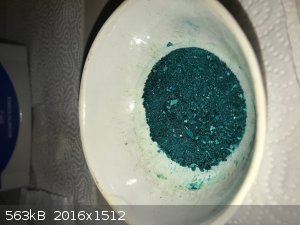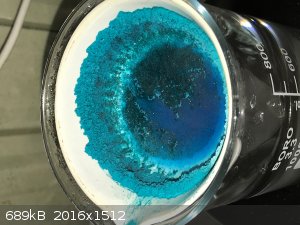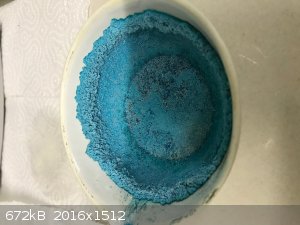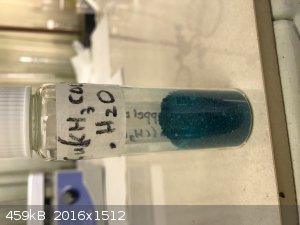Lion850
National Hazard
   
Posts: 514
Registered: 7-10-2019
Location: Australia
Member Is Offline
Mood: Great
|
|
Report on making copper ii acetate by double displacement with OTC chemicals
I made copper (ii) acetate by double displacement reaction between copper sulfate and calcium acetate:
CuSO4.5H2O + Ca(CH3COO)2.H2O = Cu(CH3COO)2.H2O + CaSO4 + 5H2O
- 30g copper sulphate (fertilizer grade) was dissolved in 120ml water (water was heated to speed up the dissolving).
- 24g calcium acetate (food grade) was dissolved in 150ml water - it dissolved easier than I expected without heating. This should put the calcium
acetate in cery slight excess.
- Mix and stir by hand for 2 minutes (at this time my magnetic stirrer was broken), the result being a very dark blue solution.
From the above quantities, the target was 21 to 23g of copper acetate depending on hydration and 16.5g of calcium sulphate
- The calcium sulphate quickly settled on the bottom of the beaker and after 30 minutes or so the dark blue solution was decanted off.
- The calcium sulphate was washed a few times until the decanted water was nearly clear and then dried on a steam bath. After 2 hours the weight of
the calcium sulphate stabilized, 17g was recovered.
- 10ml of glacial acetic acid was added to the copper acetate solution (to try and prevent excessive formation of basic copper acetate) and it was
boiled down from an initial volume of approximately 280ml.
- Boiling down stopped for the night at around 200ml and the next morning the solution was full of dark blue crystals.
- Boil down solution further to 180ml by which time I got elsewhere occupied for the rest of the day, but at that time bumping was already excessive.
- The next morning the blue solution was decanted off the settled crystals, and 24g of wet dark blue crystals was transferred to a crucible and on the
steam bath.
- The crystals dried easily and more or less stayed the same dark blue color. Drying was stopped when the weight stopped dropping, 13.4g was
recovered. See photo of the dried crystals in the crucible.
- The remaining solution was boiled down to 50ml and then transferred to the crucible to be further steamed down and dried on the steam bath.
- The copper acetate crystalised out on the sides of the crucible which was quite interesting, see photo. Eventually it was all dry, but interestingly
the color of this second batch was slightly lighter compared to the first batch. I think the fact that the 2nd batch crystalized out of solution with
the solution near boiling temperature resulted in a less hydrated product. See photo of the dried product.
- 10.3g was recovered from the second batch. This makes total recovery 23.7g.
This seems to have been quite an efficient way to make copper acetate as both the copper acetate and lead sulphide final weights were almost spot-on
with what I was aiming for (although, there could be a gram or so of calcium acetate hiding somewhere). The starting chemicals are also readily
available.
   
|
|
|
Nonexistent
Harmless

Posts: 21
Registered: 6-10-2018
Member Is Offline
|
|
Heh, what are the odds, I'm not too far from you and also started making some copper (ii) acetate a couple days ago, although a different route, and
much more drunken and lazy. I pulled out the bench grinder, grinded down some copper, added some 8% vinegar, and some 6% hydrogen peroxide (not doing
stoichiometric amounts because drunk/lazy even though it would have been easy).
Don't have a smart phone/camera so can't share, but hoping my crystals turn out as nice as yours (doubtful), as your crystals looks very nice, very
nicely done.
|
|
|
Refinery
Hazard to Others
  
Posts: 371
Registered: 17-2-2014
Member Is Offline
Mood: Still
|
|
I was gonna make lead acetate from copper acetate and metallic lead with single displacement reaction. I wonder how long it's gonna take to dissolve
all the lead.
|
|
|
Lion850
National Hazard
   
Posts: 514
Registered: 7-10-2019
Location: Australia
Member Is Offline
Mood: Great
|
|
Nonexistent - please update here with how your method worked.
Refinery - for my interest, what do you plan to do with the lead acetate or are you just making it to have in stock / for fun?
|
|
|
Syn the Sizer
National Hazard
   
Posts: 591
Registered: 12-11-2019
Location: Canada
Member Is Offline
|
|
Nice procedure, I too just created copper (II) acetate, but I went with basic copper carbonate and 7% vinegar. I am also making copper (II) citrate.
|
|
|
arkoma
Redneck Overlord
      
Posts: 1761
Registered: 3-2-2014
Location: On a Big Blue Marble hurtling through space
Member Is Offline
Mood: украї́нська
|
|
My first Copper Acetate was from copper electrodes with 5% vinegar in an electrolytic cell. In fact, was one of my very first projects. Element 29
is just plain my favorite. Beautiful color pure and absolutely lovely salts. Have Acetate, Sulphate, and Chloride (mua-ha-ha) on hand.
"We believe the knowledge and cultural heritage of mankind should be accessible to all people around the world, regardless of their wealth, social
status, nationality, citizenship, etc" z-lib
|
|
|
Nonexistent
Harmless

Posts: 21
Registered: 6-10-2018
Member Is Offline
|
|
So far a darkish blue-semi green liquid in jar, filtered through a pipette with chux cloth- some fine copper + some black and other junk sediment. Now
in an evap dish as no more beakers (ordering some this week). Going edtrememly slowly, some very fine precipitate on edges, so seems like I've got my
compound, just waiting to see.
|
|
|
Refinery
Hazard to Others
  
Posts: 371
Registered: 17-2-2014
Member Is Offline
Mood: Still
|
|
My process just took a step forward.
The calcium acetate and copper sulfate were measured and dissolved in molar ratios with slight excess of calcium. A sludge of CaSO4 formed, which
quickly settled, and clear, though so deeply blue liquid that it appeared opaque was decanted few times around to remove solids. The CaSO4, tinted
still blue, was simply discarded due to pure CaSO4 anhydrite being available in bulk at hand, and need being only in drying of solvents.
Then, the lead shots that were formed by pouring molten lead through a sieve into water, were spread in a shallow container, and the liquor was
introduced. After sitting for 12 hours, upon agitation, a solid precipitate of copper metal was clearly detectable in the deep blue liquor as a fine
sediment flow, and the lead shots surfaced were plated in copper. For the proof of concept, the single displacement reaction is proven to work.
The liquor shall remain sitting for now, and eventually I will check it. The lead is in excess, so it should consume all of the copper acetate
available, and the liquor color should diminish unless impurities are present.
Whenever it is time, it shall be decanted, filtered, concentrated and finally evaporated to dryness, procedures taking in consideration the toxicity
of organic lead contamination issues. Further purification steps could be taken if deemed necessary. A report shall follow.
|
|
|
Lion850
National Hazard
   
Posts: 514
Registered: 7-10-2019
Location: Australia
Member Is Offline
Mood: Great
|
|
Hi Refinery - Good to hear it is working. For my interest, what do you plan to do with the lead acetate?
|
|
|
Refinery
Hazard to Others
  
Posts: 371
Registered: 17-2-2014
Member Is Offline
Mood: Still
|
|
It'll likely end up in my chemical shelf. I just wanted to have it, but never bothered to make it before. I have many other acetates as well. I was
mostly fascinated about the displacement reaction and wanted to see if it really works and make something I've wanted at the same time. It would be
too boring to just use acetic acid and H2O2 because it will certainly work, alas I don't have peroxide.
|
|
|
Refinery
Hazard to Others
  
Posts: 371
Registered: 17-2-2014
Member Is Offline
Mood: Still
|
|
I wonder how long will it take to complete the displacement reaction? There is still a significant amount of lead, and the water is still very bluish
due to copper acetate presence. Could it be sped up with somehow?
|
|
|
Lion850
National Hazard
   
Posts: 514
Registered: 7-10-2019
Location: Australia
Member Is Offline
Mood: Great
|
|
I wonder if continual stirring on a magnetic stirrer will help? Keep the lead pieces rubbing together and dislodge any copper layer.
|
|
|